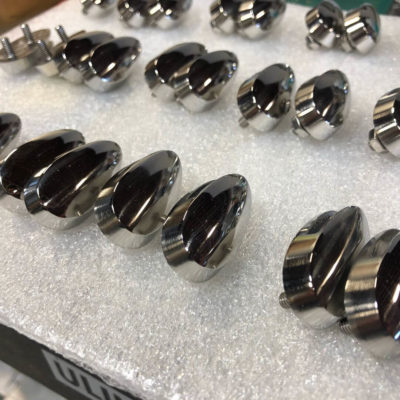Choose the Right Stainless Steel or Alloy Steel for Your CNC Machined Prototype
Do you know which type of steel you need for your CNC machined prototype?
Steel is a common manufacturing material that offers many benefits, including corrosion resistance, strength, and ductility. But as with other materials like aluminum, there’s no one-size-fits-all steel solution.
Material properties, cost, and other factors vary from one type of steel to the next, so it’s important to understand your options before making a selection for your prototype model.
Understanding the Different Types of Steel
Stainless steel and alloy steel are the most popular varieties of steel used for modern machining. There are key differences to consider between these two steel types.
Stainless Steel
Stainless steel contains 10-20% chromium, which is the main alloying material. This chemical element forms a layer of chromium oxide, giving the metal a smooth texture and protecting against corrosion.
The primary categories of stainless steel are:
- Austenitic stainless steel. This popular stainless steel is known for its high chromium content and non-magnetic property. Due to its superior corrosion resistance, it’s ideal for various applications ranging from hypodermic needles to landing gears and jet engine components.
- Ferritic stainless steel. Ferritic stainless steel is magnetic and contains high amounts of nickel, making it a more cost-effective option than austenitic stainless steel. Common applications for ferritic stainless steel include appliances, axles, shafts, and fasteners.
- Martensitic stainless steel. This stainless steel is less common than the others due to its brittle composition. But despite its fragile nature, martensitic stainless steel offers high tensile strength and solid impact resistance, making it suitable for applications like knives and bearings.
Alloy Steel
Alloy steel contains various elements—such as molybdenum, manganese, nickel, chromium, vanadium, silicon, and boron—to improve properties like strength, hardness, and wear resistance.
There are two categories of alloy steel:
- High strength, low alloy steel contains less than 8% of the alloying elements
- High alloy steel contains more than 8% of the alloying elements
Stainless Steel and Alloy Steel Options
Choosing the right steel for your part involves weighing considerations such as manufacturability, functionality, cost, and availability.
Here are some of the most machinable stainless steels you can choose from:
- 303 stainless steel. If you need a stainless steel that’s both cost-effective and strong, 303 usually fits the bill. It’s almost as easy to machine as aluminum, which helps keep machining costs down.
- 304 stainless steel. The most common stainless steel, 304 contains high chromium and nickel content to ensure excellent corrosion resistance. It’s especially useful for medical equipment and appliances.
- 316 stainless steel. When corrosion resistance is your number one priority, such as for medical applications or saltwater climates, 316 may be a better option than 304. In addition to its high chromium and nickel content, 316 contains a significant amount of molybdenum for superior corrosion resistance.
- 18-8 stainless steel. This food-grade stainless steel is commonly used in commercial kitchen applications. While it is non-magnetic in its raw form, it can become magnetic via cold-working.
- 400 series stainless steel. The 400 series stainless steel grades are typically composed of 11% chromium and 1% manganese, leaving them susceptible to rust and corrosion without proper heat-treating. Even so, these grades offer exceptional strength and wear resistance, making them a great choice for agricultural equipment, hardware, and motor shafts.
- 17-4 stainless steel. This grade of martensitic precipitation-hardened stainless steel is used for applications where strength is more of a priority than corrosion resistance. It’s possible to harden 17-4 with a single low temperature precipitation heat treatment.
- 15-5 stainless steel. This variant of 17-4 is a chromium-nickel-copper precipitation hardening stainless steel. But unlike 17-4, 15-5 can withstand temperatures up to 600 degrees Fahrenheit. It’s most commonly used in high-pressure corrosive environments and aircraft components.
If you’re looking for an alloy steel, consider these options:
- 1018 alloy steel. Classified as a low-carbon steel, 1018 is most commonly available cold-rolled. It combines strength and ductility with a smooth surface finish. This alloy steel is ideal for pins, rods, shafts, spindles, and sprockets.
- 4140 alloy steel. Also a low-carbon steel, 4140 is a chromium, molybdenum, manganese plate known for its high fatigue and torsional strength.
- 4340 alloy steel. Due to its increased carbon content, 4340 is a medium carbon, low alloy steel known for its toughness and strength after heat-treating. This alloy steel is primarily used for commercial and military aircrafts, forged hydraulics, and crankshafts.
If you’re still not sure which steel you need for your next prototype model, KAD is happy to assist. Contact us today to learn more about our prototype CNC machining services.



